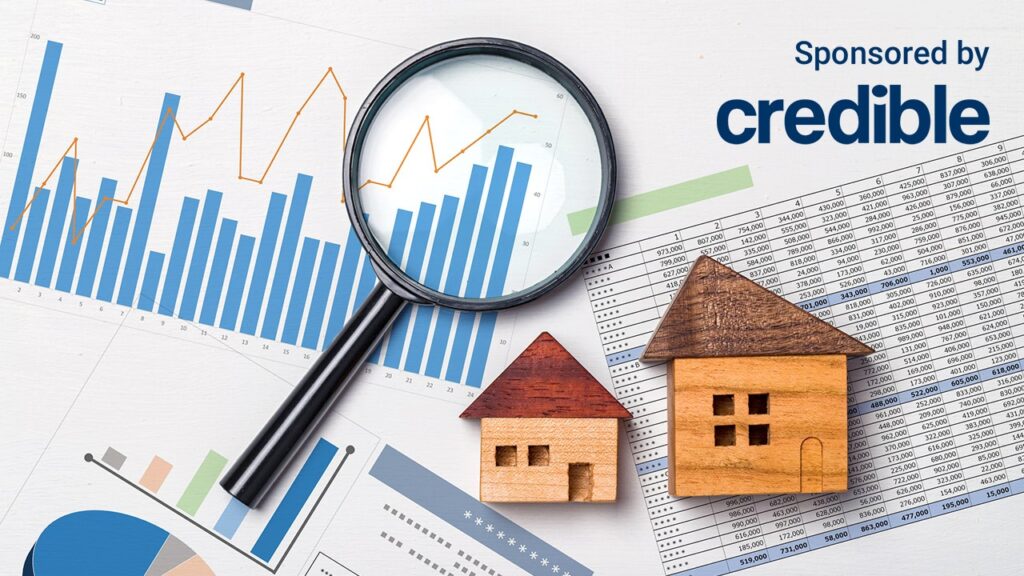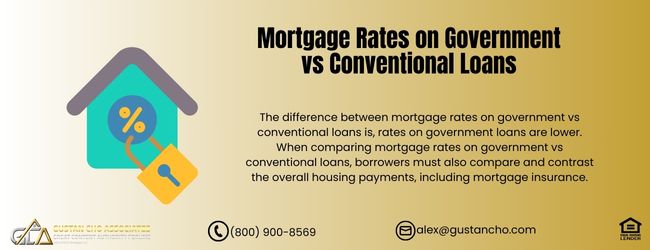Using Conventional Versus FHA Loans Due To Mortgage Guidelines

This guide covers using conventional versus FHA loans due to agency mortgage guidelines. FHA and Conventional loans are the top two home mortgage programs in the nation. HUD, the parent of FHA, is the federal agency that sets agency lending guidelines on FHA loans. HUD’s goal is to promote homeownership to first-time homebuyers and homebuyers with less than perfect credit.
HUD has easier credit guidelines on FHA loans than any other home mortgage program. Homebuyers with credit scores as low as 500 FICO can qualify for FHA loans.
To qualify for a 3.5% down payment home purchase FHA loan, the borrower needs a 580 credit score. HUD is not a lender. HUD is a federal agency that insures and partially guarantees lenders against losses sustained due to default and/or foreclosure. Due to the government guarantee by HUD, lenders are more than willing to originate, process, underwrite, and fund FHA loans with 3.5% down payment with low credit scores at competitive mortgage rates.
Choosing Between Using Conventional versus FHA Loans
Choosing between using conventional versus FHA loans depends on your financial situation, credit score, down payment capabilities, and long-term goals. Here’s a detailed comparison to help you make an informed decision:
Key Features Using Conventional versus FHA Loans
In this section, we will cover key features using conventional versus FHA loans. Conventional loans are issued by private lenders such as banks, credit unions, and mortgage companies. Typically require a higher credit score than FHA loans. A credit score of 620 or higher is usually needed, but a score of 740 or higher will get you the best rates.
Generally requires a minimum down payment of 3-20%. Some programs, like those offered by Fannie Mae and Freddie Mac, allow for down payments as low as 3%.
Private mortgage insurance (PMI) is equired if the down payment is less than 20%. PMI can be removed once the homeowner has 20% equity. Conforming loan limits set by the Federal Housing Finance Agency (FHFA) apply. For 2024, the limit for a single-family home is $766,550 in most areas, but it can be higher in high-cost areas. Speak With Our Loan Officer for FHA Loans
Pros Using Conventional versus FHA Loans
No Upfront Insurance Premium: Unlike FHA loans, conventional loans do not require an upfront mortgage insurance premium (MIP). Lower Monthly Payments: PMI on conventional loans is typically lower than FHA MIP, especially for borrowers with higher credit scores. No Lifetime Mortgage Insurance: PMI can be canceled once you reach 20% equity, whereas FHA loans require MIP for the life of the loan unless a significant down payment is made.
Cons Using Conventional versus FHA Loans
Stricter Credit Requirements: A higher credit score is needed compared to FHA loans. Higher Down Payment: Generally requires a larger down payment than FHA loans unless using a special program.
Using FHA versus Conventional Loans
FHA loans are backed by HUD, the parent of FHA and a government agency. Insured by the Federal Housing Administration (FHA), which reduces the risk for lenders. More lenient credit requirements. A minimum credit score 580 is required for a 3.5% down payment. Scores between 500-579 require a 10% down payment. Low down payment options, with a minimum of 3.5% for borrowers with credit scores of 580 or higher. Requires an upfront MIP (1.75% of the loan amount) and an annual MIP, divided into monthly payments. The annual MIP ranges from 0.45% to 1.05% of the loan amount, depending on the loan term and loan-to-value ratio. FHA loan limits vary by county and are generally lower than conventional ones. For 2024, the standard limit is $498,257 for low-cost areas and up to $1,089,300 for high-cost areas.
Pros Using FHA versus Conventional Loans
Lower Credit Score Requirements: It is easier for borrowers with lower credit scores to qualify. Lower Down Payment: Allows for a down payment as low as 3.5%. Assumable Loans: FHA loans can be transferred to a new buyer, which can be a selling point if interest rates increase.
Cons Using FHA versus Conventional Loans
Mortgage Insurance Premiums: FHA loans require both upfront and annual MIP, which can be more expensive over time. Loan Limits: Lower loan limits may restrict the amount you can borrow. Permanent Mortgage Insurance: For loans with less than 10% down, MIP is required for the life of the loan.
Speak With Our Loan Officer for Conventional Loans
Using Conventional versus FHA Loans: Which One to Choose?
So, which one do you choose? Using conventional versus FHA loans or vice versa?
Consider Using Conventional versus FHA Loans If:
- You have a good to excellent credit score (generally 620 or higher).
- You can afford a larger down payment (at least 5%).
- You want to avoid long-term mortgage insurance costs.
- You are purchasing a higher-priced home that exceeds FHA loan limits.
Consider an FHA Loan If:
- Your credit score is lower (between 500-620).
- You have a limited down payment (as low as 3.5%).
- You are comfortable with paying mortgage insurance for the life of the loan.
- You are buying a home within FHA loan limits.
By comparing these aspects, you can determine which loan type best suits your financial situation and homeownership goals.
Difference Between Using Conventional Versus FHA Loans
To qualify for a conventional loan, the borrower needs a minimum of a 620 credit score. Conventional loans are not insured and/or backed by any federal agency. Conventional loans are often referred to as conforming loans. This is because it needs to conform to Fannie Mae or Freddie Mac Agency Mortgage Guidelines. If the conventional loan does not conform to Fannie Mae and Freddie Mac agency guidelines, Fannie Mae and Freddie Mac will not purchase conventional loans funded by lenders.
Lenders need to sell the loans they fund to Fannie Mae or Freddie Mac. The role of Fannie Mae and Freddie Mac is to provide liquidity to lenders by purchasing the loans funded by lenders.
Lenders need to sell the loans they fund to the secondary market because they need to pay down their warehouse lines of credit. Fannie Mae and Freddie Mac are the two largest buyers of mortgage loans on the secondary market. Once the lender’s warehouse lines of credit are freed up, they can repeat the mortgage process by originating more home loans. In this article, we will discuss and cover the topic of using conventional versus FHA loans due to mortgage guidelines.
Using Conventional Versus FHA Loans Due To Mortgage Included in Bankruptcy

There are mandatory waiting period requirements after bankruptcy, foreclosure, deed in lieu of foreclosure, short sale. What happens if a borrower had a prior mortgage included in the bankruptcy. The mortgage in the bankruptcy was not reaffirmed and foreclosed at a later date. What happens when it comes to qualifying for a mortgage. What is the waiting period start date? How long is the waiting period? In this case scenario, conventional loans may have a shorter waiting period requirement.
If a borrower had a prior mortgage included in bankruptcy and the mortgage was not reaffirmed, there is a four-year waiting period after the discharged date of bankruptcy to qualify for conventional loans.
The date of the foreclosure, deed in lieu of foreclosure, short sale does not matter. Lenders will go from the discharged date. However, this is not the case on FHA loans. With FHA loans, there is a three-year waiting period after the recorded date of the foreclosure, deed-in-lieu of foreclosure, short sale if the borrower had a mortgage included in the bankruptcy. The discharged date of bankruptcy does not matter. In many instances, lenders will drag on finalizing foreclosures for many years. This holds true in cases where the mortgage was included in bankruptcy. Get Qualify for FHA or Conventional Loan Included in Bankruptcy
Using Conventional Versus FHA Loans Due To Higher Loan Limits
There are instances where a homebuyer needs to go with a conventional versus FHA loan when they exceed FHA loan limits.
- 2024 FHA loan limits is capped at $498,2557.
- 2024 conventional loan limits are capped at $776,550.
- Therefore, if exceed the FHA loan limit in a certain area, you may need to qualify for a conventional versus FHA loan
- Both FHA and Conventional loan limits are higher in high-cost areas
Many counties in California and other high home prices states have high-cost counties where the loan limits on FHA and Conventional loan limits are higher.
Using Conventional versus FHA Loans Due To Non-Occupant Co-Borrowers
Both FHA and Conventional loans allow for non-occupant co-borrowers. HUD, the parent of FHA, require non-occupant co-borrowers to be related to the main borrower by law, marriage, blood to qualify for a 3.5% home purchase FHA loan. HUD does allow non-occupant co-borrowers that are not related to the main borrower as well. However, if the non-occupant co-borrower is not related to the main borrower by law, marriage, blood, then HUD requires the main borrower to put a 15% down payment on FHA loans. This is not the case with conventional loans. Fannie Mae and Freddie Mac both do not require any non-occupant co-borrowers to be related to the main borrower.
Qualifying For a Mortgage With High Student Loan Balances
In the past, mortgage borrowers with high student loans had to go using conventional versus FHA loans because HUD had stricter student loan guidelines. However, HUD loosened up student loan guidelines to match Fannie Mae and Freddie Mac. High student loan balances are one of the biggest hurdles when it comes to qualifying for a home mortgage.
Instances when the lender drags on the finalization of the foreclosure for many years in cases where the borrower included the mortgage in bankruptcy, using conventional versus FHA loans is the home mortgage of choice.
HUD, the parent of FHA, no longer exempt deferred student loan balances that have been deferred for longer than 12 months. HUD requires mortgage underwriters to use 0.50% of the outstanding student loan balance as a hypothetical debt when calculating debt-to-income ratios. Income-based repayment (IBR PAYMENTS) is allowed with Conventional and FHA loans. HUD, Fannie Mae and Freddie Mac do allow income-based repayment on conventional loans. Borrowers with high student loan balance can qualify for Conventional and FHA loans.
Click here to qualify for a mortgage with hight student loan balances
FAQs: Using Conventional Versus FHA Loans Due To Mortgage Guidelines
1. What are the key differences between Conventional and FHA loans? Conventional loans necessitate a higher credit score and a down payment ranging from 3-20%. Private Mortgage Insurance (PMI) is necessary if the down payment is below 20%. FHA loans are appropriate for borrowers with lower credit scores and necessitate a minimum down payment of 3.5%. FHA loans also mandate upfront and annual mortgage insurance premiums (MIP).
2. What are the credit score requirements for these loans? The lowest credit score for conventional loans is 620, but it’s better to have a score of 740 or more to secure the most favorable rates. A credit score 580 is necessary to be eligible for a 3.5% down payment on FHA loans, whereas scores falling between 500 and 579 will necessitate a 10% down payment.
3. How do down payments compare? The standard down payment for conventional loans usually falls between 3% and 20%. Some specific programs may allow down payments as low as 3%. On the other hand, FHA loans require a minimum down payment of 3.5% for borrowers with a credit score of 580 or higher. Those with credit scores between 500 and 579 are expected to provide a 10% down payment.
4. What about mortgage insurance? Conventional loan borrowers need private mortgage insurance (PMI) for less than 20% down payments. Still, they can request cancellation once they reach 20% equity. The initial Mortgage Insurance Premium (MIP) for FHA loans is 1.75%, and an annual MIP varies from 0.45% to 1.05%. For any inquiries, please feel free to get in touch with us.
5. What are the loan limits for these loans? For 2024, conventional loans have a limit of $766,550 for a single-family home in most areas, though this can be higher in areas with a high cost of living. Additionally, FHA loans have a standard limit of $498,257 in low-cost areas, potentially increasing to $1,089,300 in high-cost areas.
6. What are the pros of using Conventional loans? Using Conventional loans has several advantages, including the absence of an upfront mortgage insurance premium. This means monthly payments can be lower if the Private Mortgage Insurance (PMI) is less expensive. Additionally, there’s no requirement for mortgage insurance for the life of the loan; PMI can be canceled once 20% equity in the home is achieved.
7. What are the cons of using Conventional loans? Conventional loans have stricter credit requirements and typically require a higher down payment unless you use a special program.
8. What are the pros of using FHA loans? FHA loans provide numerous benefits, such as facilitating qualification for borrowers with lower credit scores. Additionally, they offer low down payment options, sometimes as low as 3.5%. Moreover, these loans are assumable, which can be a major advantage in rising interest rates.
9. What are the cons of using FHA loans? When considering FHA loans, it’s important to note certain drawbacks, including the requirement for upfront and annual Mortgage Insurance Premiums (MIPs), which can increase the overall cost. Also, these loans have lower borrowing limits, which may limit the amount you can borrow. Additionally, if your down payment is less than 10%, you will be required to pay for mortgage insurance for the life of the loan.
10. When should I consider a Conventional loan? If you have a good to excellent credit score, typically 620 or higher, consider opting for a Conventional loan. This type of loan is also appropriate if you can make a larger down payment, at least 5%, and want to steer clear of long-term mortgage insurance expenses. Furthermore, it’s a feasible choice when buying a more expensive home that surpasses FHA loan limits.
11. When should I consider an FHA loan? If your credit score is between 500 and 620, an FHA loan could be a suitable choice. You could be eligible for a down payment as low as 3.5%. It’s important to note that you’ll need to pay mortgage insurance throughout the entire loan period. Also, ensure the home you plan to buy falls within the FHA loan limits.
12. How do waiting periods after bankruptcy or foreclosure differ? The waiting periods after bankruptcy or foreclosure differ depending on the type of loan. Conventional loans have a four-year waiting period after the bankruptcy discharge date, which is required regardless of when the foreclosure occurred. On the other hand, FHA loans require a three-year waiting period after the foreclosure, deed-in-lieu of foreclosure, or short sale is recorded, irrespective of the bankruptcy discharge date.
13. Can I use non-occupant co-borrowers for these loans? For conventional loans, you can use non-occupant co-borrowers without requiring them to be related to the main borrower. On the other hand, for FHA loans, non-occupant co-borrowers need to have a legal, marital, or blood relation to the main borrower to qualify for a 3.5% down payment loan. A 15% down payment is necessary if there’s no such relation.
14. How are student loans considered in these loans? In the context of FHA and Conventional loans, income-based repayment (IBR) plans for student loans are now accepted. The Department of Housing and Urban Development (HUD) mandates that mortgage underwriters consider 0.50% of the outstanding student loan balance as a hypothetical debt when calculating debt-to-income ratios.
By recognizing these fundamental variances and criteria, you can select the type of loan that most closely aligns with your financial circumstances and homeownership objectives.






Responses